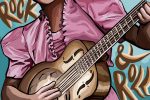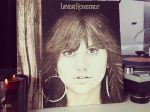The Metropolitan Museum of Art has expanded its purview once again. After hosting exhibitions about everything from the accessories of past Catholic popes in their 2018 “Heavenly Bodies” exhibition to the exploration of camp fashion following the 2019 Met Gala, the Met has now taken a dive into the world of music. In their new “Play It Loud” exhibition, the museum is showcasing the visual art that accompanied one of the most popular and influential genres of music: rock ‘n’ roll.
Upon entering Gallery 199, museum-goers are immediately immersed in another world, where rock ‘n’ roll songs are always playing. The playlist includes popular songs like “Saturday Night Fish Fry” by Louis Jordan and his Tympany Five band and “I Want to Hold Your Hand” by the Beatles; but, as this exhibition shows, the actual music was only a part of the cultural movement that was rock ‘n’ roll.
The visual aspect of rock ‘n’ roll has its own artistic value that should not go unnoticed, and the “Play It Loud” exhibition refuses to let it. The gallery displays the instruments that rock ‘n’ roll musicians used to create and play their songs, and it shows how the instruments themselves added to the appeal of these musicians. The instruments — mostly guitars, although there’s also a few drum sets, saxophones and pianos — reflect the aesthetics of the artists who used them.
For example, “Play It Loud” showcases an acoustic guitar that once belonged to Buddy Holly. The Met’s exhibition shows the instrument, J-45, which he used in his early days and might have been used to record some of his famous songs like “Everyday” and “Send Me Some Lovin’,” in an intricately-detailed leather cover with Holly’s name stitched on the bottom; the sides of the case also feature some of his lyrics and the name of his home state, Texas.
The guitar, which the Met speculates may have been made by Holly himself, is a reminder of his early country music before his later transition to rock ‘n’ roll. Holly greatly influenced the culture of rock ‘n’ roll music; the song “American Pie” by Don McLean references “the day the music died,” referring to Holly’s premature death in a plane crash.
Another prominent piece in the “Play It Loud” exhibition is the Beatles’ full set, which includes Ringo Starr’s drum set, John Lennon’s twelve-string guitar and George Harrison’s Club 40 electric guitar. The bass drum head of Starr’s set features the Beatles’ logo, with the signature “drop-T,” which was originally created by the maker of the drum set, Ivor Arbiter. The drum kit’s visual influence can still be seen today, almost 60 years later, wherever the Beatles’ logo is displayed. Furthermore, the drum kit symbolizes the Beatles’ shift to America, as it was Starr’s first American instrument.
https://www.instagram.com/metmuseum/p/BvuYFhWg0FF/?hl=en
Some of the instruments in the Met’s “Play It Loud” exhibition are famous for how iconic they are, and for their association with their artist. Eddie Van Halen’s guitar, which he called Frankenstein, is “one of the most recognizable guitars of all time,” according to the Met.
Van Halen, driven by his desire for the perfect guitar, combined the best elements from renowned guitar makers to create this unique instrument; its unorthodox appearance was matched by Van Halen’s seemingly-impossible skill with it, which led him to be recognized as one of the greatest guitarists of all time.
The “Play It Loud” exhibition also shows instruments that directly reflect the style and aesthetic of their owners. The exhibition has collected some of the instruments belonging to the band Metallica in a display that echoes the band’s heavy metal music; James Hetfield’s custom guitar, the JH-2, with its chrome diamond-plate top and spiky silhouette, is reminiscent of the band’s logo.
The display also includes Lars Ulrich’s drum kit, which is unique because of its double bass drums and “crash and ‘trash’ cymbals” — a drum setup that allowed Ulrich to produce Metallica’s fast, aggressive beat. Kirk Hammett’s “Spider 13” guitar, with a decal of a spider with a skull on top of it and another decal of the number “13,” also enhances the aesthetic of the band’s heavy metal style.
https://www.instagram.com/metmuseum/p/Bu7HvjznU4z/?hl=en
Additionally, “Play It Loud” showcases Robert Trujillo’s guitar, “Aztec De La Chloe,” which is decorated with a wood-burned pattern based off an Aztec calendar, created by Trujillo’s wife Chloe. His guitar’s design is a tribute to Trujillo’s indigenous heritage.
Some of the instruments owe their appearance entirely to the culture of rock ‘n’ roll, because they’re destroyed and broken. “Play it Loud” showcases a fragment of the guitar that Jimi Hendrix famously destroyed at the Monterey International Pop Festival in June 1967; he doused his guitar in lighter fluid and set it on fire, before smashing it to pieces.
Many artists demolished their instruments in similar ways, representing one of the core values of rock ‘n’ roll: rebellion. This attitude inspired the promotional poster “How to Launch Your Guitar in 17 Steps,” also displayed at the Met, which shows Pete Townshend, the guitarist of the band The Who, demonstrating how he smashes his instruments on stage.
“Play It Loud” is a celebration of the musical phenomenon that is rock ‘n’ roll, and that includes an appreciation of the visual art behind it. While the artists themselves are what made rock ‘n’ roll music such an influential and popular genre, they couldn’t have found success without their distinctive instruments, and “Play It Loud” appreciates how these instruments reflected their music and their values and contributed to the appeal of many rock ‘n’ roll musicians.
















